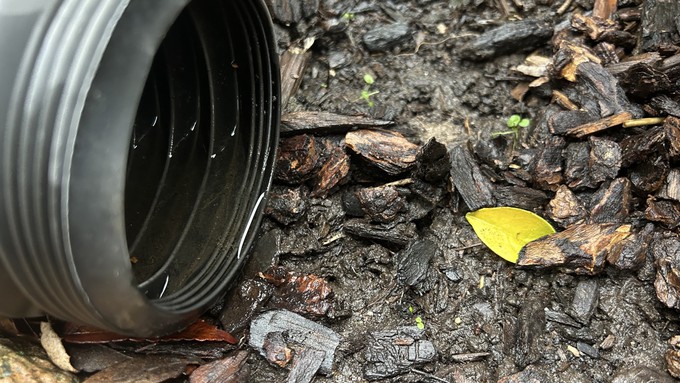
Wet weather can cause issues for gardeners with water-logged landscapes

Diverters attached to downspouts can redirect water to spots where it can soak in safely, away from foundations. Kathy Morrison
Right now, my garden seems afloat on an atmospheric river. Succulents are literally floating out of their pots after their containers filled up with water.
After an avalanche of leaves, some plants had to be dug out, too. Saturday’s deluge denuded my pistache and maples of their remaining fall foliage. The patio (and all its potted plants) is buried in a soggy mess.
At least, my trees are still standing and held onto their limbs. Other trees in the neighborhood weren’t so lucky as our wet and wild winter weather arrived early.
In the first wave of these almost-winter storm systems, Downtown Sacramento received 1.9 inches of rain between Thursday and Saturday, Dec. 12-14, including a record 1.10 inches Saturday, says the National Weather Service. Monday’s showers will push that total well over 2 inches.
Another atmospheric river is expected to hit late Friday or early Saturday. That storm should put Sacramento’s monthly total over December’s historical average of 3.25 inches.
Our landscapes can usually deal with slow, steady and well-spaced showers; the moisture percolates down into the ground.
But at some point during heavy rains, our soil “fills up” and can’t take another drop. That’s when we see pooling, puddling or worse: flooding.
During these storms, check how the water flows through your landscape. Make sure to direct it away from foundations. Connect diverters to downspouts and redirect water to spots where it can soak in safely.
Saturated soil can lead to other issues. Be on the lookout for leaning trees. Many trees and large shrubs have weakened roots due to the effects of prolonged drought. They’re more likely to fall in stormy weather.
Also at risk are large, horizontal branches on evergreen trees. So much rain adds a lot of weight. Such branches may need support.
Here are more tips to help your landscape cope with so much water:
* Turn off your sprinklers or other irrigation; your garden won’t need it for a while.
* Make sure storm drains are clear. Rake leaves and debris away from drains.
* Remove saucers from potted plants to avoid root rot.
* Succulents are most at risk in such wet weather. If they get too much rain, they rot. Move them to a sheltered location if possible.
* Avoid walking on or working with wet soil. It can compact easily, squeezing out needed air for microbes and roots. Put off any transplanting until next week after the soil has drained but remains moist. Don’t plant in soggy soil.
* If you have bare-root plants in need of transplanting, keep them in sawdust or put their roots in a bucket of water. They can stay in water for several days.
* Although the calendar says it’s time, don’t spray peach and nectarine trees during these damp conditions. Wait until we have a 72-hour window of dry weather.
* Stay on top of weather changes, which can come fast and furious. Get more weather updates here: https://www.weather.gov/sto/#
Comments
0 comments have been posted.Sacramento Digs Gardening to your inbox.
Food in My Back Yard Series
April 29: What's (already) wrong with my tomato plants?
April 22: Should you stock up on fertilizer? (Yes!)
April 15: Grow culinary herbs in containers
April 8: When to plant summer vegetables
April 1: Don't be fooled by these garden myths
March 25: Fertilizer tips: How to 'feed' your vegetables for healthy growth
March 18: Time to give vegetable seedlings some more space
March 11: Ways to win the fight against weeds
March 4: Potatoes from the garden
Feb. 25: Plant a fruit tree now -- for later
Feb. 18: How to squeeze more food into less space
Feb. 11: When to plant? Consider staggering your transplants
Feb. 4: Starting in seed starting
Sites We Like
Garden Checklist for week of May 4
Enjoy this spring weather – and get gardening!
* Plant, plant, plant! It’s prime planting season in the Sacramento area. Time to set out those tomato transplants along with peppers and eggplants. Pinch off any flowers on new transplants to make them concentrate on establishing roots instead of setting premature fruit.
* Direct-seed melons, cucumbers, summer squash, corn, radishes, pumpkins and annual herbs such as basil.
* Harvest cabbage, lettuce, peas and green onions.
* In the flower garden, direct-seed sunflowers, cosmos, salvia, zinnias, marigolds, celosia and asters. (You also can transplant seedlings for many of the same flowers.)
* Plant dahlia tubers. Other perennials to set out include verbena, coreopsis, coneflower and astilbe.
* Transplant petunias, marigolds and perennial flowers such as astilbe, columbine, coneflowers, coreopsis, dahlias, rudbeckia and verbena.
* Keep an eye out for slugs, snails, earwigs and aphids that want to dine on tender new growth.
* Feed summer bloomers with a balanced fertilizer.
* For continued bloom, cut off spent flowers on roses as well as other flowering plants.
* Add mulch to the garden to maintain moisture. Mulch also cuts down on weeds. But don’t let it mound around the stems or trunks of trees or shrubs. Leave about a 6-inch to 1-foot circle to avoid crown rot or other problems.